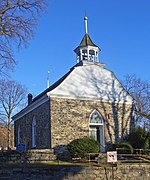Philipsburg Manor House
1693 establishments in the Province of New YorkGrinding mills in New York (state)Grinding mills on the National Register of Historic Places in New York (state)Historic house museums in Westchester County, New YorkHouses completed in 1693 ... and 8 more
Houses on the National Register of Historic Places in New York (state)Living museums in New York (state)Mill museums in the United StatesNational Historic Landmarks in New York (state)National Register of Historic Places in Westchester County, New YorkOpen-air museums in New York (state)Sleepy Hollow, New YorkU.S. Route 9

Philipsburg Manor House is a historic house in the Upper Mills section of the former sprawling Colonial-era estate known as Philipsburg Manor. Together with a water mill and trading site the house is operated as a non-profit museum by Historic Hudson Valley. It is located on US 9 in the village of Sleepy Hollow, New York. Although an English-deeded tract, it is listed by some sources with the patroonships of New Netherland since it incorporated part of that previously owned by Dutch Jonkheer Adriaen van der Donck.
Excerpt from the Wikipedia article Philipsburg Manor House (License: CC BY-SA 3.0, Authors, Images).Philipsburg Manor House
North Broadway,
Geographical coordinates (GPS) Address Nearby Places Show on map
Geographical coordinates (GPS)
| Latitude | Longitude |
|---|---|
| N 41.088527777778 ° | E -73.863611111111 ° |
Address
Philipsburg Manor
North Broadway 381
10591
New York, United States
Open on Google Maps








